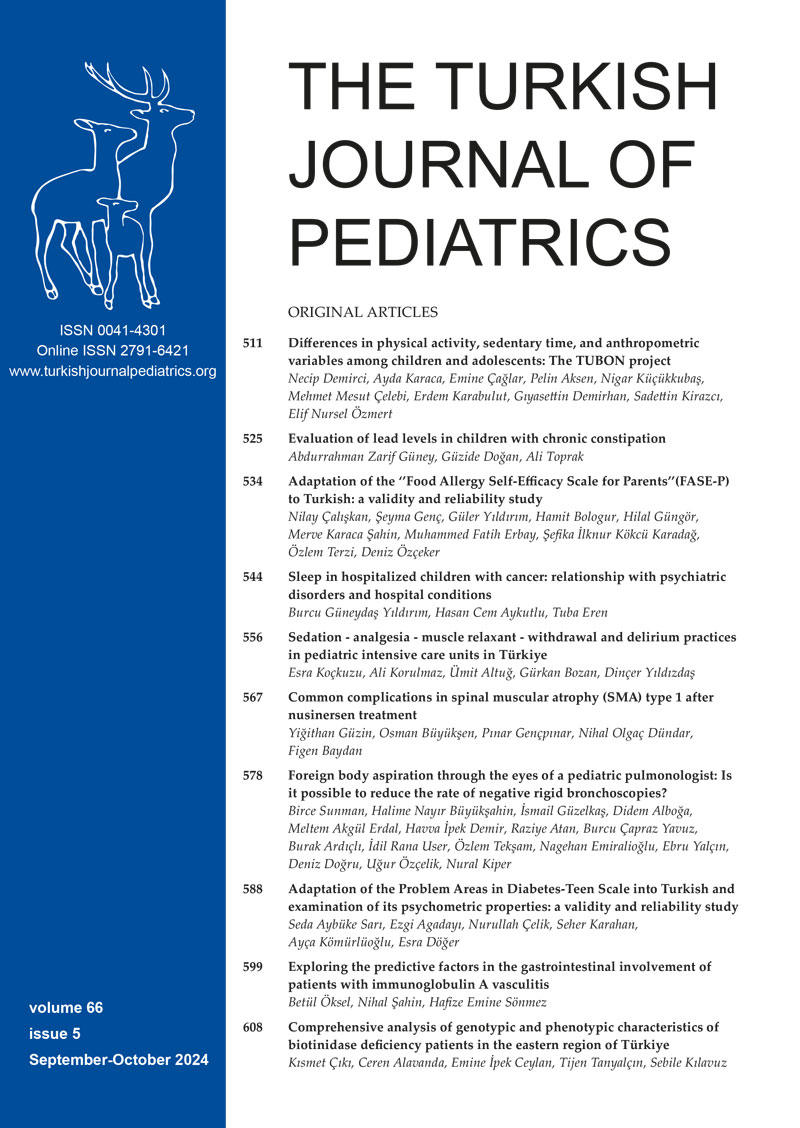Abstract
Background. Sexual abuse in children can sometimes result in sexually transmitted infections (STIs), which can serve as crucial forensic evidence. Although PCR methods are now accepted as the gold standard for STI screening, they have not yet widely replaced traditional culture methods in Türkiye. This study aims to assess the necessity of implementing PCR-based STI testing at Child Advocacy Centers in Türkiye, where such testing is not routinely available.
Methods. Conducted between February and November 2023, this study included children who presented to the Child Advocacy Center of Marmara University Pendik Training and Research Hospital. High-risk victims were identified based on criteria including a history of penetrative sexual abuse and factors such as multiple perpetrators or significant age disparity. Serological tests and genital swabs were collected and analyzed using both bacterial culture methods and a comprehensive STI PCR panel.
Results. The study included 20 victims, with a median age of 16 years. STI PCR testing detected pathogens in 19 out of 21 samples, including Chlamydia trachomatis (20%) and Neisseria gonorrhoeae (5%). In contrast, culture methods identified no sexually transmitted pathogens.
Conclusion. PCR testing demonstrated significantly higher sensitivity for detecting STIs compared to traditional bacterial culture methods, as expected. Implementing PCR-based STI testing in Child Advocacy Centers is an urgent and essential need for providing an accurate diagnosis and robust forensic evidence, enhancing the care and legal protection of sexually abused children.
Keywords: nucleic acid amplification test (NAAT), sexually transmitted disease, child monitoring center
References
- Girardet RG, Lahoti S, Howard LA, et al. Epidemiology of sexually transmitted infections in suspected child victims of sexual assault. Pediatrics 2009; 124: 79-86. https://doi.org/10.1542/peds.2008-2947
- Kellogg ND, Farst KJ, Adams JA. Interpretation of medical findings in suspected child sexual abuse: an update for 2023. Child Abuse Negl 2023; 145: 106283. https://doi.org/10.1016/j.chiabu.2023.106283
- Kimberlin DW, Barnett ED, Lynfield R, Sawyer MH, editors. Red Book: 2021-2024 Report of the Committee on Infectious Diseases. American Academy of Pediatrics; 2021.
- T.C. Resmi Gazete. Türk Ceza Kanunu. Available at: https://www.resmigazete.gov.tr/eskiler/2004/10/20041012.htm
- Seña AC, Hsu KK, Kellogg N, et al. Sexual assault and sexually transmitted ınfections in adults, adolescents, and children. Clin Infect Dis 2015; 61(Suppl 8): S856-S864. https://doi.org/10.1093/cid/civ786
- Centers for Disease Control and Prevention (CDC). Sexually Transmitted Infections Treatment Guidelines, 2021: Sexual Assault or Abuse of Children. Available at: https://www.cdc.gov/ std/treatment-guidelines/sexual-assault-children. htm (Accessed on March 12, 2024).
- Centers for Disease Control and Prevention (CDC). Sexually Transmitted Infections Treatment Guidelines, 2021: Sexual Assault and Abuse and STIs – Adolescents and Adults. Available at: https://www.cdc.gov/std/treatment-guidelines/sexual-assault-adults.htm (Accessed on March 12, 2024).
- Okiring J, Getahun M, Gutin SA, et al. Sexual partnership concurrency and age disparities associated with sexually transmitted infection and risk behavior in rural communities in Kenya and Uganda. Int J Infect Dis 2022; 120: 158-167. https://doi.org/10.1016/j.ijid.2022.04.038
- Kellogg ND, Melville JD, Lukefahr JL, Nienow SM, Russell EL. Genital and extragenital gonorrhea and chlamydia in children and adolescents evaluated for sexual abuse. Pediatr Emerg Care 2018; 34: 761-766. https://doi.org/10.1097/PEC.0000000000001014
- Hernández Ragpa L, Valladolid Urdangaray A, Ferrero Benéitez OL, Díez Sáez C. Sexually transmitted infections in the context of a sexual assault. Enferm Infecc Microbiol Clin (Engl Ed) 2019; 37: 187-194. https://doi.org/10.1016/j.eimc.2018.11.004
- Park JH, Kim N, Shin S, Roh EY, Yoon JH, Park H. Prevalence and correlated factors of sexually transmitted infections among women attending a Korean sexual assault center. J Forensic Leg Med 2020; 71: 101935. https://doi.org/10.1016/j.jflm.2020.101935
- Skjælaaen K, Nesvold H, Brekke M, et al. Sexually transmitted infections among patients attending a sexual assault centre: a cohort study from Oslo, Norway. BMJ Open 2022; 12: e064934. https://doi.org/10.1136/bmjopen-2022-064934
- Black CM, Driebe EM, Howard LA, et al. Multicenter study of nucleic acid amplification tests for detection of chlamydia trachomatis and neisseria gonorrhoeae in children being evaluated for sexual abuse. Pediatr Infect Dis J 2009; 28: 608-613. https://doi.org/10.1097/INF.0b013e31819b592e
- Qin X, Melvin AJ. Laboratory diagnosis of sexually transmitted ınfections in cases of suspected child sexual abuse. J Clin Microbiol 2020; 58: e01433-e01419. https://doi.org/10.1128/JCM.01433-19
- Folaranmi TA, Kretz CB, Kamiya H, et al. Increased risk for meningococcal disease among men who have sex with men in the United States, 2012-2015. Clin Infect Dis 2017; 65: 756-763. https://doi.org/10.1093/cid/cix438
- Marchand-Senécal X, Bekal S, Pilon PA, Sylvestre JL, Gaudreau C. Campylobacter fetus cluster among men who have sex with men, Montreal, Quebec, Canada, 2014-2016. Clin Infect Dis 2017; 65: 1751-1753. https://doi.org/10.1093/cid/cix610
- Workowski KA, Bachmann LH, Chan PA, et al. Sexually Transmitted Infections Treatment Guidelines, 2021. MMWR Recomm Rep 2021;70(No. RR-4):1–187. http://doi.org/10.15585/mmwr.rr7004a1
Copyright and license
Copyright © 2024 The Author(s). This is an open access article distributed under the Creative Commons Attribution License (CC BY), which permits unrestricted use, distribution, and reproduction in any medium or format, provided the original work is properly cited.















